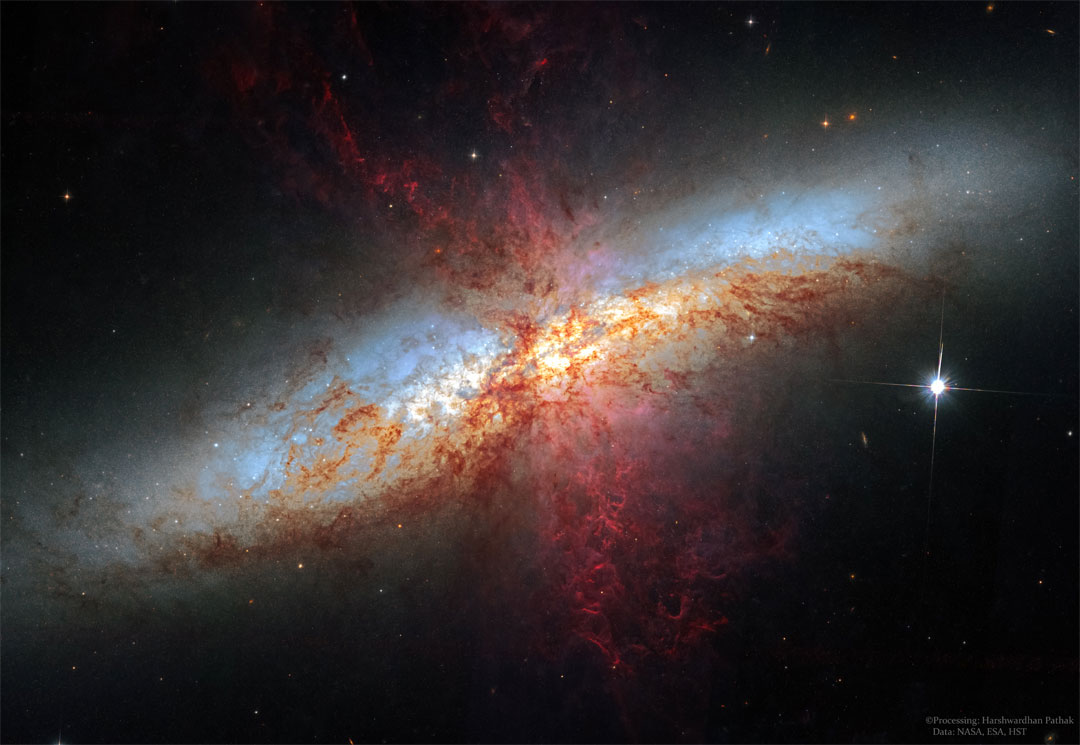Nombre total de pages vues
10/08/2023
GEMMOLOGIE - L’orthose, un minéral extraterrestre
ASTRONOMIE - Une boule de feu a enflammé le ciel de l'Australie et ce n'était pas une météorite !
ART FRACTAL - Fractale artificielle de Mandelbrot
ASTRONOMY - Five Meters over Mars
2023 August 10
Image Credit: NASA, JPL-Caltech, Ingenuity
Explanation: On mission sol 872 (Earth date August 3) Ingenuity snapped this sharp image on its 54th flight above the surface of the Red Planet. During the flight the Mars Helicopter hovered about 5 meters, or just over 16 feet, above the Jezero crater floor. Tips of Ingenuity's landing legs peek over the left and right edges in the camera's field of view. Tracks visible near the upper right corner lead to the Perseverance Mars Rover, seen looking on from a distance at the top right edge of the frame. Planned as a brief "pop-up" flight, Ingenuity's 54th flight lasted less than 25 seconds. It followed Ingenuity's 53rd flight made on July 22 that resulted in an unscheduled landing.
AERONAUTIQUE - INVENTIONS QUI N'ONT JAMAIS VOLE - L'ornithoptère
07/08/2023
ASTRONOMY - The Pelican Nebula in Gas, Dust, and Stars
2023 August 7
Credit & Copyright: Abe Jones
Explanation: The Pelican Nebula is slowly being transformed. IC 5070 (the official designation) is divided from the larger North America Nebula by a molecular cloud filled with dark dust. The Pelican, however, receives much study because it is a particularly active mix of star formation and evolving gas clouds. The featured picture was produced in three specific colors -- light emitted by sulfur, hydrogen, and oxygen -- that can help us to better understand these interactions. The light from young energetic stars is slowly transforming the cold gas to hot gas, with the advancing boundary between the two, known as an ionization front, visible in bright orange on the right. Particularly dense tentacles of cold gas remain. Millions of years from now, the Pelican nebula, bounded by dark nebula LDN 935, might no longer be known as the Pelican, as the balance and placement of stars and gas will surely leave something that appears completely different.
06/08/2023
MACRO PHOTOGRAPHIE - l’anémone en mouvement

ASTRONOMY - SN 1006: A Supernova Ribbon from Hubble
2023 August 6
Credit: NASA, ESA, Hubble Heritage (STScI/AURA); Acknowledgement: W. Blair et al. (JHU)
Explanation: What created this unusual space ribbon? The answer: one of the most violent explosions ever witnessed by ancient humans. Back in the year 1006 AD, light reached Earth from a stellar explosion in the constellation of the Wolf (Lupus), creating a "guest star" in the sky that appeared brighter than Venus and lasted for over two years. The supernova, now cataloged at SN 1006, occurred about 7,000 light years away and has left a large remnant that continues to expand and fade today. Pictured here is a small part of that expanding supernova remnant dominated by a thin and outwardly moving shock front that heats and ionizes surrounding ambient gas. The supernova remnant SN 1006 now has a diameter of nearly 60 light years.
04/08/2023
ASTRONOMY - Moonrays of August
2023 August 4
Image Credit & Copyright: Gianni Tumino
Explanation: A Full Moon rose as the Sun set on August 1. Near perigee, the closest point in its almost moonthly orbit, the brighter than average lunar disk illuminated night skies around planet Earth as the second supermoon of 2023. Seen here above Ragusa, Sicily, cloud banks cast diverging shadows through the supermoonlit skies, creating dramatic lunar crepuscular rays. The next Full Moon in 2023 will also shine on an August night. Rising as the Sun sets on August 30/31, this second Full Moon in a month is known as a Blue Moon. Blue moons occur only once every 2 or 3 years because lunar phases take almost a calendar month (29.5 days) to go through a complete cycle. But August's Blue Moon will also be near perigee, the third supermoon in 2023.
02/08/2023
ASTRONOMY - M82: Galaxy with a Supergalactic Wind
2023 August 2
NASA, ESA, Hubble; Processing & Copyright: Harshwardhan Pathak
Explanation: Why is the Cigar Galaxy billowing red smoke? M82, as this starburst galaxy is also known, was stirred up by a recent pass near large spiral galaxy M81. This doesn't fully explain the source of the red-glowing outwardly expanding gas and dust, however. Evidence indicates that this gas and dust is being driven out by the combined emerging particle winds of many stars, together creating a galactic superwind. The dust particles are thought to originate in M82's interstellar medium and are actually similar in size to particles in cigar smoke. The featured photographic mosaic highlights a specific color of red light strongly emitted by ionized hydrogen gas, showing detailed filaments of this gas and dust. The filaments extend for over 10,000 light years. The 12-million light-year distant Cigar Galaxy is the brightest galaxy in the sky in infrared light and can be seen in visible light with a small telescope towards the constellation of the Great Bear (Ursa Major).
ASTRONOMY - Comet Lemmon's Wandering Tail
2025 November 17 Comet Lemmon's Wandering Tail Image Credit: Ignacio Fernández Explanation: What has happened to Comet Lemmon's ta...

-
2022 September 26 All the Water on Planet Earth Illustration Credit: Jack Cook, Adam Nieman, Woods Hole Oceanographic Institution ; Data ...
-
2025 May 11 The Surface of Venus from Venera 14 Image Credit: Soviet Planetary Exploration Program , Venera 14 ; Processing & Copyri...








